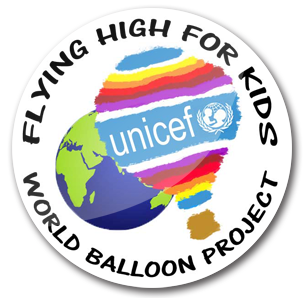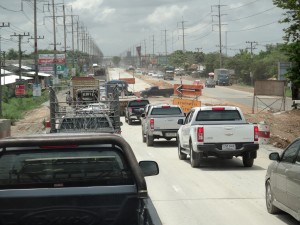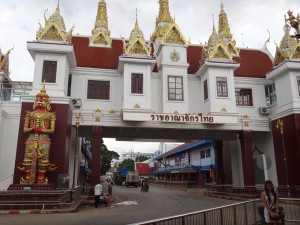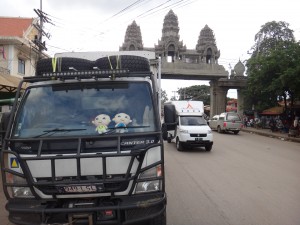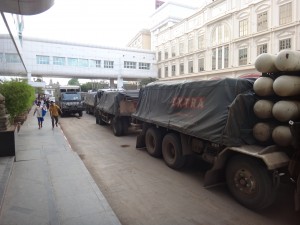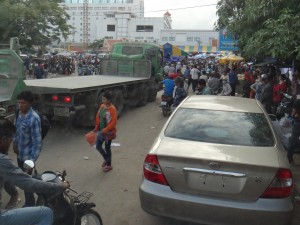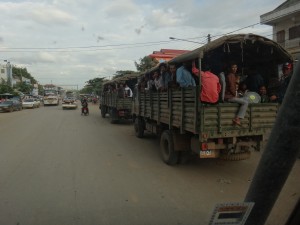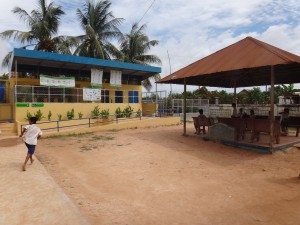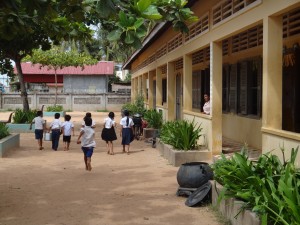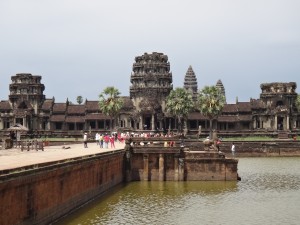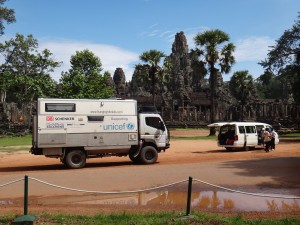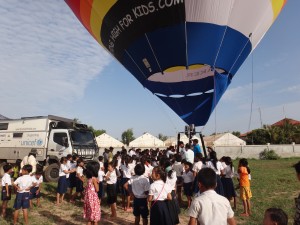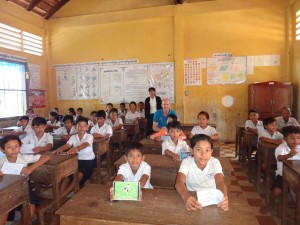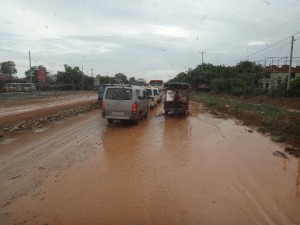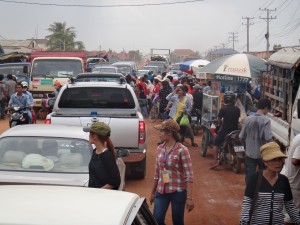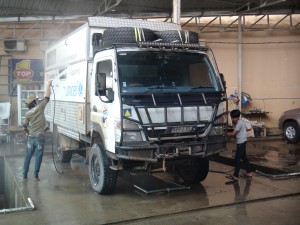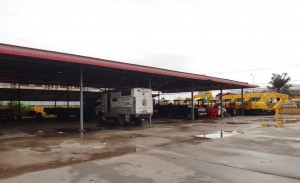Goodbye Malaysia
June 13, 2014Interesting times in Phnom Penh
July 7, 2014I left Bangkok and made my way to the Cambodian border, around 260kms away. They are upgrading the road and not far out of Bangkok was a huge traffic jam caused by the roadworks and a lot of rain, (it looked like the road had been flooded the night before). Once through, the driving was OK. One of the roads I took wasn’t on my GPS, but was on Google Maps I had on my phone. I am using my phone a lot as it is much more detailed than my Garmin. When the maps were loaded in Kuala Lumpur, they must’ve only loaded the very basic version in the other countries as only the main roads are showing. I don’t mind though as I don’t like to rely solely on GPS. It is good to find the best route before I go on a trip because the navigation on Google Maps isn’t always right.
I made the Cambodian border at Paoy Paet in around 4hrs and managed to find Thai Customs. They were very helpful and were a bit confused about my carnet. I pointed out what they needed to sign and stamp and moved on to Immigration. The guy at Immigration told me I didn’t have all the right paperwork for my truck and sent me back to Customs, (a short walk). Customs couldn’t understand why the guy sent me back, but photocopied a couple of pages from my carnet, which I then took back to Immigration. The official was very pedantic and worked through a lot of papers. My passport was stamped by another Immigration official and I was on my way. There was more paperwork going out of Thailand than coming in.
I drove through no-mans land and looked for the Cambodian Immigration. I stopped and asked a couple of police. It turned out that they could issue me with a visa on arrival, so it was a good place to stop. They did it in 5mins and pointed me in the direction of Immigration which was a bit further down the road. I stopped along with a number of other trucks and went to get my Passport stamped. A policeman was outside yelling instructions to people through a loudhailer to people passing through the border, which was entertaining.
I went back to the truck and was in the next lots of trucks to pass through the border, (they do a few at a time). It was complete chaos on the other side with thousands of people everywhere. People were being loaded onto army trucks and buses and being taken away. The road was completely blocked, but various policeman made good use of their whistles and people got out of the way for me. I looked for Customs to stamp my truck, but missed it, so I had to do a U-turn and go back into the throng of people. I managed to park my truck and went into the Customs compound. It was strange as no one was around given the chaos outside. The Cambodian official stamped my carnet and I was on my way after 5 mins. I interrupted him from stamping thousands of blank pieces of paper. It seemed very odd.
I since found out that it was much busier than usual at the border because the new military-run government in Thailand told all the illegal Cambodian workers to go back to Cambodia or face imprisonment. 100,000 workers crossed the border over a few days. Army trucks were being used to pick people up and transport them to various provinces. Speaking to UNICEF about it, they had asked the government to provide food and shelter in the trucks and when they arrived at their destination. Some people had travelled for a couple of days without food. The government agreed with UNICEF and the necessary arrangements were made.
The first half of the 150km trip from the border to Siem Reap was on a perfect two land road, (one lane in each direction). I was thinking the roads are so good here in Cambodia and I was quite surprised. I saw a very big broken down truck, completely overloaded with people not far from the border. I was wondering how long they would have to wait to get on another truck.
Once it got dark, all changed. The road was being repaired and parts of the road were completely ripped up. A warning of a repaired section of road was a black barrel in the middle of the road, which could only be seen at close range. I didn’t manage to hit any luckily. You also have to watch out for motorbike and cars without lights and more importantly, people. There are no street lights in the villages, so the place is very dark and difficult to see anything.
I got to Siem Reap after just under three hours and found a place to stay.
I went to UNICEF’s office the following morning and talked to them about the school visit. We went to the school, which was just next door, and spoke to the principal. He was a very serious person and never smiled. He showed me the toilet block which had just been put in last year. It was very nice and a huge change to their last ones, which were just holes in the ground.
That afternoon I went to Angkor Wat and Angkor Thom. Angkor Wat dates back to the 12th century and is the largest religious monument in the world. It started as a Hindu temple, but then became Buddhist. Angkor Thom is down the road from Angkor Wat and covers a much bigger area, (9 km²) and consists of a large number of temples scattered throughout the forest. It was the last and most enduring capital city of the Khmer Empire.
It was amazing to walk around the old ruins and to imagine how it was all those years ago. You could spend days walking around all the temples there are so many.
The following couple of days in Siem Reap was spent planning the trip in Cambodia, Laos and Thailand, plus seeing the sights and sounds of Siem Reap.
On the Thursday morning I went to the school. I arrived at 6.30am and some of the guards for UNICEF and the World Food Programme, (they are in the same compound) helped me to set the balloon up. The kids came from the school, which was just a couple of minutes walk away. They were amazed to see the balloon. I kept it inflated for around 25mins and they asked me questions. They also helped me pack the balloon up, which I think was their favourite part. I went to the school after and spoke to the older class, who were between the ages of 11 and 14. There is a large age gap because some kids start school at a later age. There are between 30 and 50kids in each class. They made some postcards for me and I shared postcards with them, which I had collected from kids in New Zealand and Australia. I also spoke to them about New Zealand and what I was doing. It was a great morning and the kids looked like they really enjoyed it.
After the school visit, I drove the 320kms to Phnom Penh. Almost the whole road is under construction and is in awful condition. It ranged from quite a good sealed road to a bone-jarring, potholed dirt road. It didn’t help that heavy showers had just passed through, (I managed to avoid them) which turned the road into a red clay with surface flooding in parts.
Eventually they will have good roads here, but it will take a long time. It is marred by corruption and cost-cutting.
I was happy to arrive into Phnom Penh around 6hrs later. I looked for a secure place to park the truck. This involved choosing a main road which looked good on the map but turned out to be the worst road I have ever driven on in a city. They had ripped up the whole road and just left it I think. Amazingly it is a main road in Phnom Penh. I was just hoping that my truck would get through it unscathed. I was wondering why all the cars were turning off before they reached it: I don’t think it was even possible to take a normal car down it, the potholes were so deep and the road was flooded in parts from the afternoon showers. It took an additional hour to go down that road and another 30mins to actually find a place to park. I parked outside an ATM with two security guards and thought that must be secure enough.
The next day I went to get my truck washed as it had turned red after the trip the day before. It was washed for US$15. Everything here is listed in $US as well as the Cambodian Reil. Everyone prefers $US as it is a more stable currency.
In the afternoon, I went to see the school where I will inflate the balloon and then met one of my volunteer helpers, Philip Sen. He is helping me with organising the Camboadia and Laos part of my trip and has been invaluable. He has worked with NGO’s in the past, including UNICEF, and now runs a communications company: www.tell-our-story.com
We both went to the UNICEF office to discuss the school visit and tether in Phnom Penh. During the meeting I found out that we were given permission to inflate the balloon at Wat Bottom the following Friday. Wat Bottom is a park and temple just a couple of hundred metres from the Royal Palace. After the meeting, I caught a ride on the back of Philip’s motorbike to check the place out.
That evening I found a place to park the truck next to a restaurant and the next morning I asked a couple of hotels whether I could park and stay in the truck there. Both said no. I was on my way to check out a truck park which one of the hotel workers had recommended to me, when I decide to drop into a mechanic to check out an issue with the truck’s engine overheating when it is above 33deg and going at highway speeds. I didn’t see it as a big issue, but thought it is better to be safe than sorry. I dropped into a professional looking place called Multico, which sells and services heavy machinery. After looking over the engine, they thought it was probably a problem with the thermostat and they thought greasing of the cooling fan would probably be a good idea also. They said wait until Thailand where there is better servicing for Fuso.
I had a good two hour chat with the boss and sales manager. The boss’s family has a lot of businesses in Cambodia, including owning a port, construction company, heavy machinery distributor, forestry company, among others. It was interesting to hear his Father’s story of how he started the company after the Khmer Rouge fell with only the clothes he wore and some ‘Dunlop Sandals’, (sandals made out of tyres).
He said I can park and stay at the garage for as long as I wanted. It is the perfect place for me as I can keep the truck undercover and has all the facilities, including wifi.
This week I have a tether at a school on Tuesday and the Wat Bottom tether on Friday. After that I will be heading to Laos via Thailand.
